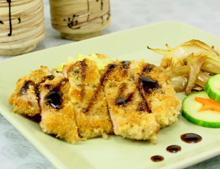Posted on May 31, 2010 by cookwithkathy

Panko is the Japanese word for “bread crumbs”. The crumbs are made fresh from specially baked, crustless bread. With an oblong shape, Panko crumbs are larger, crispier and lighter, so they coat without “packing” like regular bread crumbs used in Western cuisine, allowing foods to stay crispier longer.
The flaky panko is used in Japanese cuisine as a crunchy coating for fried foods such as Outside Japan, it is becoming more popular for use in Asian and non-Asian dishes. The flakes have large surface area and absorb seasoning well. Panko is excellent on fish and seafood.
It is often available in Asian markets and specialty stores. Increasingly, it is also available in many large supermarkets.
Filed under: Cooking Class, Ingredient | Comments Off on Panko
Posted on May 30, 2010 by cookwithkathy

Fennel is crunchy and slightly sweet, adding a refreshing contribution to the ever popular Mediterranean cuisine. Most often associated with Italian cooking, be sure to add this to your selection of fresh vegetables from the autumn through early spring when it is readily available and at its best.
Fennel is composed of a white or pale green bulb from which closely superimposed stalks are arranged. The stalks are topped with feathery green leaves near which flowers grow and produce fennel seeds. The bulb, stalk, leaves and seeds are all edible. Fennel belongs to the Umbellifereae family and is therefore closely related to parsley, carrots, dill and coriander.
Read more ….
See my related posts:
Filed under: Cooking Class, Ingredient | Tagged: Recipe | Comments Off on Fennel
Posted on May 30, 2010 by cookwithkathy
Below are the dishes I am going to teach in the cooking class.
Stir-fried Shrimp with Fennel

Breaded Veal with Lemon Sauce

Stir-fried Egg with Smoked Salmon

See my related posts:
Filed under: Cooking Class, Food | Tagged: Chinese, Photo | Comments Off on Modern Chinese Cuisine II
Posted on May 30, 2010 by cookwithkathy

Researchers found that among more than 38,000 Dutch adults they followed for a decade, those who got the most vitamin K in their diets were about 20 percent less likely to be diagnosed with type 2 diabetes during the study period.
Vitamin K exists in two natural forms: vitamin K1, or phylloquinone, found largely in green leafy vegetables, as well as some vegetable oils, such as canola and soybean oils; and vitamin K2, or menaquinone, which people get mainly through meat, cheese and eggs.
Read more ….
Filed under: Food, Health, News and Articles | Tagged: Diabetes, Vitamin | Comments Off on Vitamin K Linked to Lower Diabetes Risk
Posted on May 29, 2010 by cookwithkathy

Consumers who opt for organic foods often believe they are improving their health, but there is currently no strong evidence that organics bring nutrition-related health benefits, a new research review finds.
A “disappointingly small” number of well-designed studies have looked at whether organic foods may have health benefits beyond their conventional counterparts’, according to the review, by researchers with the London School of Hygiene and Tropical Health in the UK.
Moreover, they found, what studies have been done have largely focused on short-term effects of organic eating — mainly antioxidant activity in the body — rather than longer-term health outcomes. And most of the antioxidant studies failed to find differences between organic and conventional diets.
Read more ….
Filed under: Food, Health, News and Articles | Tagged: Organic | Comments Off on No Health Benefit Difference between Organic and Conventional Foods








